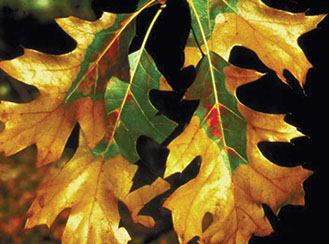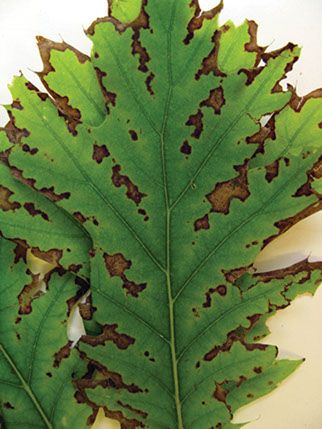
Spring/Summer 2017
Tree Disease Alert: Oak Wilt Disease and Bacterial Leaf Scorch
Oak wilt disease is a devastating disease capable of killing maturing oaks in only a few weeks. Outbreaks of the disease have been recently confirmed in Brooklyn and Long Island. Forestry officers in New Jersey and Connecticut are keeping a sharp eye out for signs of this deadly fungus. There is no cure once a tree is infected. Inoculating trees prior to infection and stopping the disease from spreading are the only options available.
Oak wilt disease is caused by a fungus called Ceratocystis fagacearum, which causes the vessels that carry fluids up through the tree to become clogged. The tree is unable to circulate water and nutrients to its branches and leaves — so it wilts and dies. The species commonly affected are black oak, pin oak, Northern red oak, burr oak and white oak.
Symptoms include leaf discoloration, loss of tree crown, fungal spores under the tree bark, early leaf drop and death of the tree. Leaves turn dull green or bronze, look water-soaked, wilt, and then turn yellow or brown and begin to fall.
The fungus that causes oak wilt disease can spread both above ground and underground. The fungal spores emit a sweet odor that attracts sap-feeding beetles and bark beetles, which can pick up the spores and spread the fungus from infected trees to healthy trees sometimes miles away. It spreads underground through the connected roots of trees or root grafts. It is reminiscent of Dutch elm disease that devastated the elm population in the country in a similar way. Infected firewood and other wood materials pose a threat as well because they can harbor the fungus and spread the disease to other regions far away.
There is currently no treatment for oak wilt disease. All that can be done is to try to prevent infection and to stop it from spreading through various means:
- Macro-injections of individual trees with a special fungicide prior to infection has been found to offer resistance for the disease.
- Trenching: Once a tree is infected, digging down and severing the root connections with other nearby trees can prevent the disease from spreading.
- Trees that have tested positive need to be removed and their stumps ground or treated with herbicide to stop the spread of the fungus. Removed trees should be chipped entirely if possible, and if necessary burned, debarked or buried.
- Quarantines that prohibit/regulate the movement of potentially diseased wood including firewood are already in place and will be expanded as the disease spreads.
* * * * *
Bacterial leaf scorch is another tree disease that we are seeing more of in our region. It affects shade trees such as oak, sycamore, maple, and elm. The disease is caused by the bacterium Xylella fastidiosa, which grows and multiplies in the water-conducting tissue (xylem) of affected trees. It is spread by leafhoppers and treehopper insects. As the disease spreads through the tree, it disrupts the transport of water resulting in scorched leaves, decline, and death of the tree.
Bacterial leaf scorch usually appears in late summer and continues through autumn. The margins of leaves on affected branches (typically in the upper third) dry up and turn brown in an irregular pattern. There is often a yellow or brown region between the margin of scorched and healthy tissue. Affected leaves may fall prematurely. Periods of drought can increase the severity of the disease.
There is currently no cure for bacterial leaf scorch. It is a chronic disease that causes a slow decline in the aesthetic beauty of the tree, and ultimately kills it. Increasing the vitality, health and vigor of a tree through mulching, watering and fertilization can make it more resistant to the disease. Injecting a tree with an antibiotic such as Oxytetracycline (OTC), periodically, can also reduce symptoms and slow down the development of the disease.
Talk to your arborist about testing for oak wilt disease and bacterial leaf scorch — as well as treatment options. Cost, location, and value are factors that can determine the course of action.



LOCATIONS:
Lower Westchester County, NY and New York City
58 Beechwood Ave, New Rochelle, NY 10801
914-576-0193
Upper Westchester (North of I-287)
15 Broadway, Hawthorne, NY 10532
914-741-1510
Fairfield County, Connecticut
80 Lincoln Avenue, Stamford CT 06902
203-348-4111
Bergen & Passaic Counties, NJ
504 High Mountain Road, North Haledon, NJ 07508
973-636-6711
Contact us for a Free Consultation